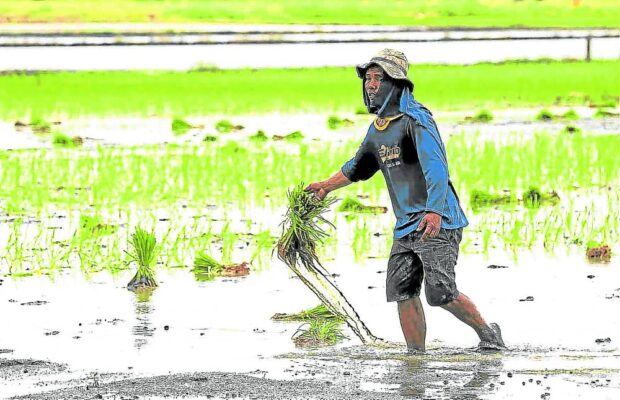
STARVING FARMERS About 25 percent of households that rely on farming in the Philippines do not have food security. —INQUIRER FILE PHOTO
MANILA – One out of 10 households in the Philippines does not have enough food on the table and those from the poorest regions starve the most, based on a report by the World Food Program of the United Nations.
Among the country’s seven poorest regions, Eastern Visayas, Central Mindanao and the Bangsamoro Administrative Region in Muslim Mindanao are the three most “food insecure.”
“Households that rely on agricultural livelihoods are also significantly more food insecure,” the report said, adding that about a quarter of such households were food insecure compared with only 9 percent among non-agricultural households.
Time and again, President Ferdinand Marcos Jr has expressed his aspiration to achieve food security. He himself has taken the arduous task of handling the agriculture portfolio since assuming power last year. The first item on the agenda of the Department of Agriculture (DA) is that every Filipino consumer must have access to adequate and nutritious food at affordable prices.
Global supply chain disruptions caused by the COVID-19 pandemic, coupled with Russia’s invasion of Ukraine, has made it all the more difficult to curb the upswing of food prices in the retail markets.
“High global commodity prices and currency depreciations fueled domestic inflation, as the country is a net importer of most staple foods, fertilizer and fuel. In addition, weather disturbances and lower domestic production of certain commodities such as sugar and salt have also pushed food prices higher,” said a report from the World Bank titled “Bracing for Headwinds, Advancing Food Security.”
The country certainly felt the brunt of steep fuel and fertilizer prices.
Data from the Fertilizer and Pesticide Authority showed the price of urea, the most commonly used fertilizer, was selling for P2,056.81 per 50-kilo bag as of the first week of April. Average price has softened from P2,861.64 a year ago but current price is still double the level seen in 2021. “As much as possible, we want to increase production. That is, I think, what the mandate of DA is all about, to really increase local production, but there is only a limit to what we can do,” Agriculture Undersecretary Mercedita Sombilla said at a hybrid event organized by the American Chamber of Commerce of the Philippines Inc.
“Whatever it is, the gap should really come from the outside. Otherwise, everyone is going to starve,” Sombilla said.
Guarded optimism
Elias Jose Inciong, president of United Broiler Raisers Association, believes it is more than possible for the Philippines to attain food security.
“First, we should put in place systemic measures based on our commitments with the WTO (World Trade Organization). Then, there should be price side and cost side interventions for the sector as practiced by other countries,” said Inciong in a message to the Inquirer.
“The most important step is [to have] meaningful consultations and [put] an end to the typical ‘top-down, we know better’ approach inflicted upon the sector,” he added.
Manuel Lamata, president of the United Sugar Producers Federation of the Philippines, said food security would be doable, particularly bolstering sugarcane production, provided that all lands covered by the agrarian reform program, as well as those sized one hectare and below, would be clustered in 50 hectares and up to achieve a large-scale farm.
Lamata said all government or military bases should be inspected for possible expansion sites, such as for new sugar mills and plantations. One imperative is to improve postharvest facilities, roads and irrigation, he said. “Government [should] give out harvesters and machineries to the cluster farms as a startup [support]. I think with that, we can achieve food security,” he told the Inquirer in a message.
To import or not
For Ronnel Arambulo, national spokesperson of Pamalakaya, an alliance of activist fisherfolk groups, “the continued crisis in the agri-fisheries production is a manifestation of the Marcos administration’s incompetence and negligence.”
“Vulnerable sectors do not fail to call for solutions to address the inflation and attain food security, such as the prompt and widespread distribution of subsidies and economic aid to fisherfolk and farmers, who are losing income as a result of the increase in production costs,” Arambulo said.
“Fisherfolk also call for the strengthening of local production and ending fish importation, especially amid the decline of the peso against the dollar, which is driving up the price of imported fish in the local market,” he said.
He lamented that the government, instead, continued to pursue policies that flood the local market with imported agricultural products.
“Fisherfolk and farmers urgently need a new and more capable agriculture secretary who, apart from devoting full time to the department, will strive to address the challenges besetting the agri-fisheries sector,” he said.
World Bank recommendations
All is not lost on the Philippines, which has yet to fully recover from the aftermath of local and international events that put upward pressure on food prices.
The same World Bank study makes the following recommendations to ensure food security in the future:
- focusing on diversification to ensure greater balance in sectoral priority-setting and resource allocation
- repurposing public agricultural expenditures in line with the strategic vision of the new administration
- investing in extension services to ensure greater thrust on capacity development for local government units
It also proposed scaling up “climate smart” agriculture policies and programs to foster increased resilience of the agri-food system to weather shocks and reduce greenhouse gases emissions from the sector, improving budget priority to support programs that overcome barriers to farm consolidation and achievement of economies of scale and improving budget priority and process. INQ

